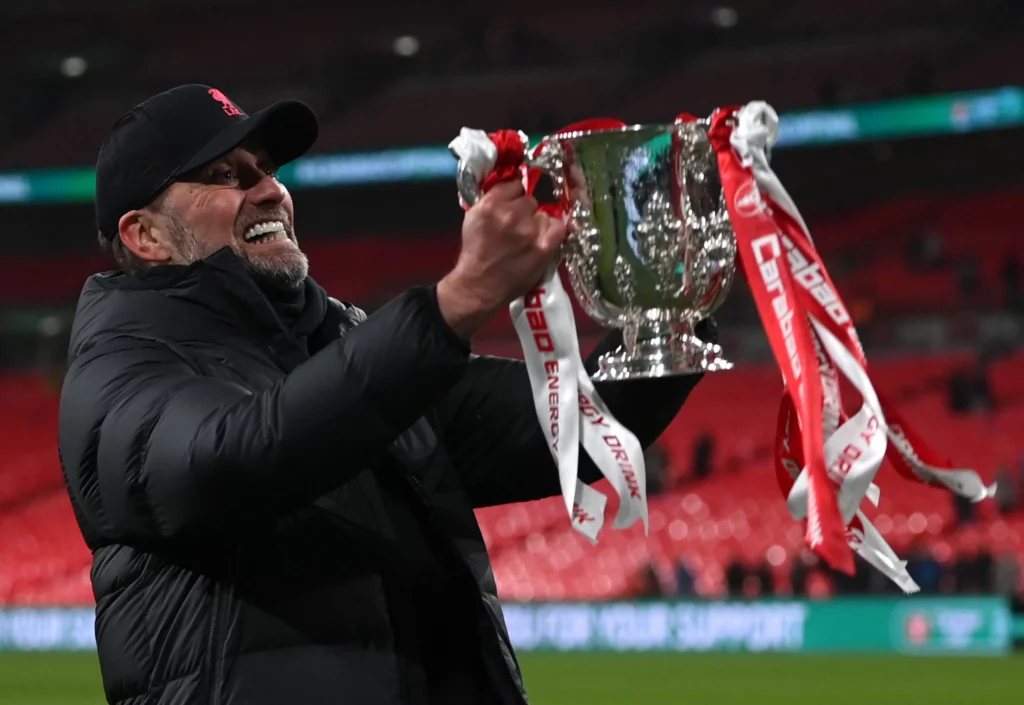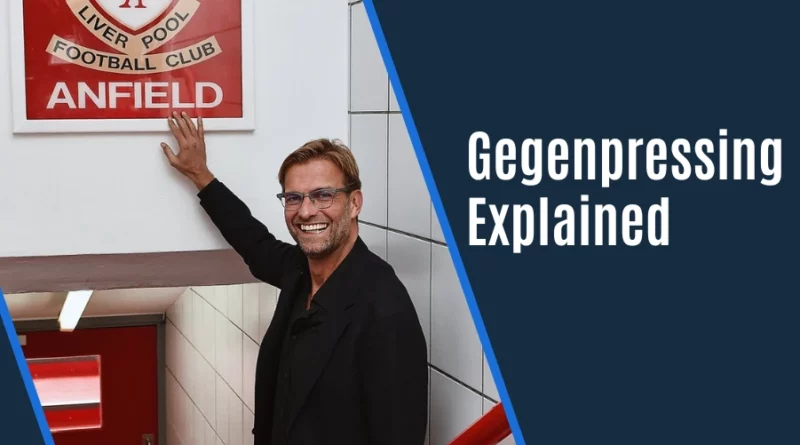What Is Gegenpressing? The Tactic That Jurgen Klopp Is Widely Known For!
Football, as they say, is a game of tactics. Sometimes, it is not just 22 players battling it out for supremacy on the field. It is also the battle of two people guiding them from the sidelines. Like a game of chess, two managers go head to head to try and win through tactics. One similar tactic that has had a lot of success recently is gegenpressing.
Gegenpressing is a simple but effective tactic. When used correctly, it can turn games into one-sided affairs. But when used incorrectly, it is going to be a field day for the opposition. You might’ve heard a lot about gegenpress and its importance in today’s scenario.
The tactic was created by Ralf Rangnick, who earned the tag of “Godfather” of gegenpressing. But it was pioneered by the charismatic ex-Liverpool manager Jurgen Klopp. The German manager arrived in Liverpool in 2015 and promised he would change the club’s fortunes. He brought his gegenpressing style and delivered on his promise by introducing the English fans to this exhilarating tactic.
Well, if you’re worried about what gegenpressing is, do not fret. We, at Sportsdunia, will break it down for you and explain everything there is to know about this tactic. We will delve into the meaning of the word, how it originated, how to implement it and who are the masters of it.
Gegenpressing Meaning and Origin

Germans are well-renowned for their tactics in all walks of life. From innovative creations to pathbreaking discoveries and first-of-its-kind technologies, they have done it all. Similarly, Germans have also given a lot of love and attention to football and have come up with their own versions of famous tactics.
Having already contributed to football through their “Blitzkrieg” tactics, they came up with one more tactic in “Gegenpressing”.
The word “gegen” in German translates to “against” in English. When combined with the football term pressing, it becomes gegenpressing. Hence, gegenpress translates to counter-pressing in simple football terms. Gegenpressing football is often called “Heavy Metal Football”, similar to “Heavy Metal Music”.
Gegenpressing’s origins would take us back to the early 2000s in the Bundesliga. German manager Ralf Rangnick is widely regarded as the architect of this tactic. During his time as a manager, he was inspired by Ukrainian manager Valeriy Lobanovskyi, whom he encountered in a game. The Ukrainians’ pressing methods were quite unique and forced Rangnick to tinker with them and implement them.
He implemented the first versions of gegenpress during his stints with VFB Stuttgart, Hannover 96 and Schalke 04. However, his spell at TSG Hoffenheim between 2006-2011 saw him revolutionise the sport with gegenpressing. His exciting Hoffenheim side was known for their high attacking output, intensity and being fun to watch.
It turned everyone’s eyes towards them. During the same period, these tactics were closely observed by fellow German coaches like Jürgen Klopp, Thomas Tuchel and Julian Nagelsmann. The managers often credit Rangnick for their success with gegenpressing around the world.
Also Read: What Is an Inverted Fullback?
What Is the Gegenpressing Tactic?
Gegenpressing, in layman’s terms, means to win the ball back from an opposition immediately after losing it. Gegenpress is often deployed in the advanced areas of the pitch. The tactic is built on the principle that a team is not in a comfortable position if it wins the ball back suddenly. The team that just lost the ball takes advantage of it and jumps onto the players who won the ball to retrieve it.
Though gegenpress is often used in the attacking areas, it is slightly acceptable to see it as an offensive tactic. But in reality, it is a form of “forward” defending or also the first line of defending, as the main aim is to win the ball back as soon as possible.
To explain it even better, let us assume the following scenario: A team is attacking continuously with numbers in midfield, and the opposition is defending well. A pass from the attacking side is intercepted by a defensive midfielder of the opposition side. The player believes they have the time to drive forward with the ball or find a pass. In this short window, the attacking side does not retreat into their defensive shape after losing the ball.
Rather, they would pounce on the defensive midfielder who won the ball and also close off all the passing lanes available, so they win the ball back effectively. If they do manage to win the ball, they can swarm forward with momentum and hurt the defence who would’ve breathed a sigh of relief thinking they won the ball back. In a flash, the attacking side that just lost the ball can win it back and go forward to score.
This is the essence of gegenpressing. While using this tactic, each player must have a clear and specific role. They must be full of running and should have the stamina to keep doing the same throughout the game.
It is the responsibility of the coach to identify the strengths of every player and use them on the pitch. A player has to be the designated ball winner, and the others have to back them up by cutting off the passing lanes successfully. A successful gegenpress needs hours and hours of practice on the training ground.
The main difference between pressing and gegenpressing lies here, as pressing involves putting pressure on the opposition with the ball, but gegenpressing involves pressing to win the ball right after losing it.
Advantages of Gegenpressing
Gegenpressing was embraced by so many top coaches around the world. Though it started in Germany, Jurgen Klopp’s exploits in Liverpool forced other coaches to give it a go. One of the main advantages of gegenpressing is its intensity and the ability to hunt in numbers. As soon as an attacking team loses the ball, they hunt the ball like a pack of wolves with the utmost intensity to win it back. Since gegenpressing often takes place in the final third, there is a chance of quickly scoring a goal.
Gegenpress has certain triggers, and it is the coach’s job to identify them and propagate them to their players. A few of these triggers could be a loose/bad touch by the player winning the ball, a loose pass to a teammate by the opposition and a player receiving a pass on their weaker foot isolated from their teammates.
The idea of gegenpress is to force mistakes from the opposition by putting them under pressure. If they can squeeze the ball holders, they will be bound to make some mistakes on which the pressing side can capitalise. When used rightly, teams can completely dismantle the opposition by scoring some quick goals. They can also completely disrupt the play-out from the back tactic by the opponents.
However, like any coin having two sides, there are a few disadvantages to this system as well.
Also Read: Top 5 managers with comfortable formations and tactics in the world of football
Disadvantages of Gegenpressing
One of the primary disadvantages of gegenpressing is the need for an excellent structure. Each and every player in the system must be proficient in covering 2-3 roles at once if their side is going to gegenpress. They must be full of stamina and energy to last for 90 minutes.
Teams like Marcelo Bielsa’s Leeds United are famous for suffering the “Bielsa Burnout” after playing high-intensity football. For this system to work out, the squad needs to be assembled in the best of ways. Only big clubs with the best resources who can spend well can use this tactic. Also, it is a staple for attacking sides, as we rarely see underdog and defensive sides using this tactic.
One of the newest disadvantages to the gegenpressing system is coming from modern coaches who are developing technical and modern players. They are filling the pitch with players who can receive the ball from any angle and hold it comfortably. The ability to pass it safely the first time or hit a long line breaker is much appreciated. The rise of ball-playing centre-backs and goalkeepers has acted as an antidote to the system.
Once the mistakes aren’t coming regularly, gegenpress becomes utterly useless as the attacking sides commit more bodies forward with little defensive shape being maintained. If the opposition can play their way out of the press, they could have a field day with the defence that will be short at the back. Hence, gegenpressing has to be done carefully in certain scenarios when the attacking side is sure of winning the ball back.
Best Formation for Gegenpressing Tactics
Ralf Rangnick’s Hoffenheim side used an out-of-fashion 4-4-2 to implement gegenpressing in Germany. He used two strikers to occupy the centrebacks as the wingers swarmed the fullbacks. The central midfielders used to hold the centre of the pitch as the fullbacks swarmed forward to form a 2-4-4 shape. It used to completely outnumber the opposition middle and defensive thirds, leading to a turnover again.
Rangnick once schooled Jurgen Klopp’s Dortmund 4-1 in the league using gegenpress. This forced Klopp to study the gegenpressing tactics and use them in his 4-2-3-1 formation to win two back-to-back league titles in 2010 and 2011. His 4-2-3-1 gegenpress was the talk of the whole footballing world back then.
His Dortmund side was a treat to watch as they pressed in a 2-1-4-1 structure to win the ball back. Later on at Liverpool, Klopp resorted to a 4-3-3 football formation with which he successfully used gegenpressing. The 3-5-2 formation that offers excellent central dominance in the middle of the pitch is also one of the best formations for gegenpressing tactics.
Best Gegenpressing Sides

Even though Ralf Rangnick invented it, Jurgen Klopp’s teams have always been one of the best gegenpressing sides the world has ever seen. He has done it twice with Borussia Dortmund and Liverpool to win multiple league and UEFA Champions League titles. Klopp can be seen as the modern pioneer of gegenpressing, as he always talks about that in his conferences.
He said, “ Gegenpressing lets you win back the ball nearer to the goal. It’s only one pass away from a really good opportunity. No playmaker in the world can be as good as a good gegenpressing situation, and that’s why it’s so important.”
His Liverpool side used a 4-3-3 formation and gave new meaning to gegenpressing tactics. He omitted a number 10 in the midfield and asked his midfield to cover the defence and provide the bite to win the ball back on transitions. His striker would do the job of a number 10, and the wingers would attack the box. The fullbacks bomb forward and provide wide support.
During gegenpressing, this looks like a 2-3-5 and helps them suffocate the opposition as they see no teammates in the vicinity to clear their lines. His side won the Champions League and Premier League in back-to-back years. They also fell short of the league title twice and lost a couple of Champions League finals.
Another side that matches similar gegenpressing tactical superiority is Pep Guardiola’s Manchester City. The legendary Spanish tactician who perfected tiki-taka also played around with gegenpressing. He believes a side is most vulnerable in the first six seconds of winning the ball and asks his side to break them down in those six seconds. He won six league titles in England, along with a Champions League title.
Also Read: Ranking The 10 Best Coach In The World Right Now (2025)
FAQs
Who came up with Gegenpress?
Germany’s Ralf Rangnick came up with gegenpress.
Who is the godfather of Gegenpressing?
Ralf Rangnick is the godfather of Gegenpress.
What is an example of Gegenpress?
Winning the ball back immediately after losing it is an example of Gegenpress.
What is the difference between tiki-taka and gegenpressing?
Tiki-taka involves playing crisp one-touch passes to break the opposition down, whereas gegenpressing involves hunting them down after losing the ball to win it back.
How to counter Gegenpressing?
Playing long passes and first-time passes perfectly is an effective way to counter gegenpressing.
